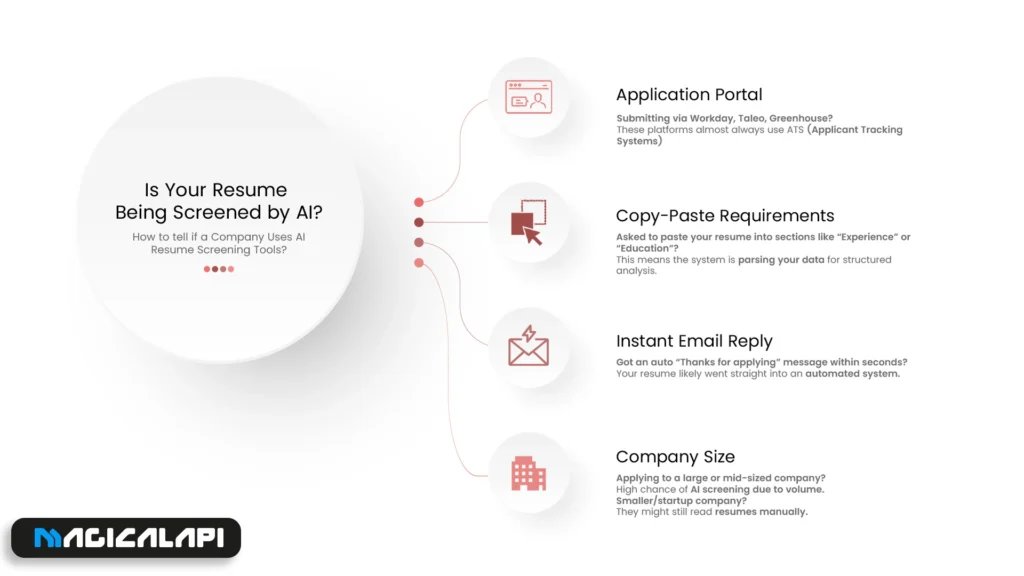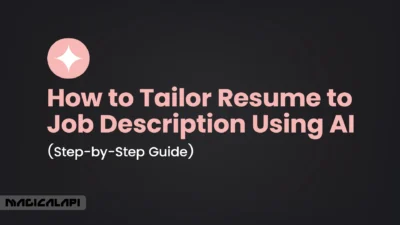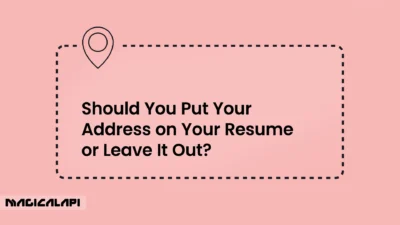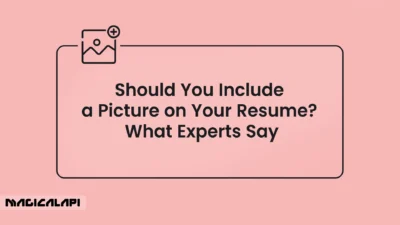This guide will walk you through everything you need to know about AI resume screening, helping you make an informed decision that boosts your job search success.
The contemporary job market can feel like a moving target. The kind of technology that determines the application process is rapidly evolving, and applying for a job looks much different than it did just a few years ago. One of the most significant differences is everything having to do with Artificial Intelligence (AI) being used to screen applicants and resumes. It has many job seekers wondering: Should I opt out of AI resume screening when given the chance?
This is a fair question to ask yourself. The idea of a robot deciding on your career is easy to see how it can be alarming. You might feel a sense of wanting to run from the machine and get your meticulously crafted resume straight to the hands of a human being.
But the question isn’t that simple. While there are appropriate situations where opting out is unhelpful, just like opting in, most people want the results to support their chances of getting the job. Opting out in the wrong contexts might not produce the magic bullets one might think, and might simply get the applicant thrown out all.
This guide will provide you with everything you need to know to better should you opt out of ai resume screening and empathize with AI resume screening, to provide you with an informed option during your job search that supports your success as a candidate.
Table of Contents
What Is AI Resume Screening and How Does It Work?
Before you can decide to opt out, it’s important to know what the AI resume screening system does. AI resume screening is the process of leveraging AI and machine learning algorithms to assist with the automated first-pass evaluation of job applications. This technology is typically embedded in what is called Applicant Tracking Systems (ATS).
Let me simplify it a little bit:
- Parsing: Upon receiving a submission of your resume, the first action the AI takes is called parsing. A Resume Parser tool scans/indexes/ingests relevant information from the typed text in your resume (name/contact info, work history, education, skills) to build a digital profile that will be housed in the company’s database.
- Keyword Matching: Then the AI will scan that profile to identify specific keywords and phrases that the hiring manager, at a minimum, wants to make sure are identified within their list of applicable resumes for the role they are servicing. Typically, those keywords are simply pulled from the job description being reviewed. The AI may search for technical skills (e.g., Python, SEO, AutoCAD), soft skills (e.g., project management, team leadership), or qualifications (e.g., master’s degree, PMP).
- Scoring and Ranking: The AI will analyze the level of match between the information in your resume and the job requirements and will assign a score to your application. Each applicant will then be assigned a ranking, and the application with the highest score (according to the algorithm) will be first in line for the human recruiter to review.
For the companies, their goal is to be more efficient, because a single corporate job opening could have hundreds or even thousands of relevant applications. AI enables the recruiter to quickly scan through all of these applications to highlight candidates that look the most suitable on paper.
Magical Resume Parser
Discover the powerful capabilities of the Magical Resume Parser and explore the various options available to streamline your hiring process, optimize candidate selection, and enhance recruitment efficiency.
How to Tell If a Company Uses AI Resume Screening Tools
While many larger and mid-sized businesses will use some kind of AI screening or ATS, they don’t always present this information in their hiring practices. That said, here are a few indicators that your application will likely trek through either one or maybe even both:
- Online job applications portals: If you’re submitting through an oversized generic portal on the employer’s career page (i.e., Workday, Taleo, Greenhouse, etc.), then you can almost be certain an ATS is being utilized.
- Field-based required submissions: Does the job application require you to copy and paste components of your resume into several text boxes (i.e, “Work Experience,” “Education,” etc.)? If so, that is usually a telltale indication that the system is parsing your information for its database.
- Receiving automated response: “Thank you for your application” confirmation email immediately after hitting submit: if you receive an automated response email that was generated either moments or even sometimes seconds after you submitted your application, it is an indicator that your application was logged to an automated application tracking system.
- Company size: Significant companies will rely on automation more than smaller ones due to the sheer volume of applicants with a larger established company. However, human providence through either resume reading or ATS deployment is less typical for startups or smaller businesses, which may still read through every actual resume.
Pros and Cons of AI Resume Screening for Job Seekers
The growth of AI in hiring presents pros and cons for applicants. An awareness of both sides will inform your decision as to whether you want to choose to opt out of ai resume tracking.
Advantages (Reasons to Opt In)
- More visibility and opportunity: The downside is that in today’s job market, many organisations are going to use these systems. When you opt in, you’ll be in the primary candidate pool. If you choose not to allow it, you could be entirely overlooked for consideration.
- Efficiency and Speed: AI can process your application on the spot and recognize you as a fit candidate much faster than a human can. This could speed up the hiring process and get your resume in front of a recruiter faster.
- Potential for a reduction of human bias: Theoretically, a properly programmed AI can be more objective than a human reviewer. It cannot consider unconscious bias that might relate to the candidate’s name, age, gender, or university. It is strictly focused on the data around each candidate’s skills and experience, making this step less likely to favor one applicant over another.
Read More: How to Use AI to Write a Resume
The Cons (Reasons for Concern)
- Limited Nuance: AI misses context. If you have a nontraditional career path, a gap in employment, or some other unusual skill set, the algorithm may not understand how your experience translates into the role. Unlike humans, it can’t read between the lines.
- Algorithmic Bias: An AI can only be as good as the data it was trained on. If the historical hiring data used to train the AI reflects existing biases, then the AI may learn and perpetuate them. For example, the AI may negatively filter qualified candidates who don’t have the same background as the past qualified candidates the AI recognizes as successful hires.
- Keyword Overreliance: AI screening often feels like a competition of “keyword bingo.” If the right phrasing is not included in the resume copy that the algorithm is scanning, you may be filtered out, even though you may be highly qualified. This forces candidates to optimize for robots rather than discovering their true selves.
- Lack of Transparency: You frequently do not know how the AI is scoring your resume or why you were rejected. This black box nature makes it nearly impossible to know what to improve on for future applications.
Magical Resume Checker
Discover the full potential of the Magical Resume Checker and explore the various options available to enhance your resume, optimize it for applicant tracking systems (ATS), and improve your chances of landing your dream job.
When Could Opting Out Be a Smart Move?
While it is usually risky, there are a few specific instances where opting out, if possible, may be a good strategy:
- Applying to Small Companies or Startups: A small business with a few employees is unlikely to have invested in an HR system with ATS. In these cases, your application is likely going directly to a founder or hiring manager, so it is best to opt for a more personalized approach.
- You Have a Strong Internal Referral: If an employee at the company is referring you for a position, they may be able to submit your resume to the hiring manager or the recruiter directly. This human-to-human handoff will likely avoid initial AI screening altogether. This is one of the best ways to ensure you will get seen.
- Applying for Highly Creative or Niche Roles: For creative roles like senior graphic designer, creative director, or research scientist, the portfolio, body of work, or list of publications is often more critical than the resume itself. In these industries, direct outreach to the head of the department or use of a personal reference may be more effective than submitting through a typical HR portal.
Should You Opt Out of AI Resume Screening? Key Considerations

The question of whether you should opt out is ultimately a strategic one that depends on your particular situation. In the case of most applicants applying for corporate roles, the answer is most likely no. Should you opt out of ai resume screening entails weighing the risks and the benefits.
The crux of the matter is that, in most cases, the choice is not really between an AI review and a human review; the choice may be between an AI review and no review at all. Many application systems have built AI into how applications are reviewed – AI will be first and auto-deductible. If you decline to consent, then you could be delayed, manually reviewed by staff (this queue does get mislaid), or your application may simply be rejected altogether.
Before you consider opting out, ask yourself:
- What is the application option? If the application is through a big company’s typical online application portal, attempting to opt out is risky.
- Do I have another option? If you know someone at that company, you could potentially reach out to the hiring manager via LinkedIn. If you have any sort of “backdoor” to get your resume seen by a human, the risk of opting out of the formal process is much lower.
- Is my experience very nonlinear? If your experience is very nonlinear, and you are confident that an AI is not going to recognize the value proposition of your experience, you could direct all of your energy into networking or direct outreach as opposed to applications. However, at least consider submitting a tailored and AI-friendly version of your resume via the application portal, as a backup plan.
The key question is not “Is it prudent to opt out?” but rather “What is the best route for me to be seen?” In most cases, that route is to be working with the AI, instead of against it.
Artificial Intelligence resume screening refers to the use of AI-powered software or Applicant Tracking Systems (ATS) that automatically review, rank, and filter resumes before a human recruiter ever sees them. Instead of manually reading thousands of applications, recruiters rely on AI to speed up hiring and reduce bias (at least in theory).
How It Works
- Keyword Matching
- AI scans resumes for keywords related to skills, job titles, certifications, and experience from the job description.
- Contextual Understanding
- More advanced AI looks beyond keywords → it understands synonyms, variations, and context (e.g., “Python developer” ≈ “Software Engineer with Python expertise”).
- Scoring & Ranking
- Each resume gets a score (sometimes called an ATS score or resume match rate) based on how well it aligns with the job posting.
- Filtering
- Resumes below a threshold may be rejected automatically; the rest are forwarded to hiring managers.
When Opting Out of AI Screening Could Hurt Your Job Search
Let’s be honest: it’s a gamble not to opt in the current hiring landscape. Most modern hiring workflows are in place specifically because of the efficiencies afforded by AI, which is not a winding road to navigate if you choose to go your own way.
First of all, it may mean you are omitted altogether. Some systems are even configured to auto-archive all applications not permitted for automated processing. You may be saying no to being screened by AI to hold out for a human evaluator, but you might actually be saying no to even getting an application into the building.
Second, it might delay matters substantially. Even if you are not omitted, it may mean being sent to a secondary folder for possibly being looked at manually by someone with the least amount of sourcing format in their own best interest, left to their already overwhelmed last priority. While AI-screened candidates are being looked at or being scheduled to come for interviews, you could be sitting unseen for weeks, at which point the opening is already filled. The decision of should I opt out of AI resume screening is now a little clearer if we equate this risk with being ignored altogether.
Read More: AI Resume Optimization
How to Make Your Resume AI-Friendly Without Compromising Authenticity
Instead of opting out, your better option is to optimize your resume to get past the screening of the AI. This does not mean you would write a robotic resume with excessive keywords. You would just take your real skills and experience and write them in a format that the technology can read.
- Mimic the Job Description: The AI is looking for keywords from the job description, so use them. If the job posting says “experience in digital marketing and content strategy,” your resume must include those exact phrases once (assuming you have that experience). Do not interchange them for synonyms such as “online advertising and article scheduling.”
- Avoid complicated formatting: Fancy fonts, columns, tables, and graphics can confuse a Resume Parser. Instead, use a clean, professional, single-column layout in a standard font such as Arial, Calibri, and Times New Roman. Use standard headings like “Work Experience,” “Education,” and “Skills.”
- Quantify Your Achievements: AI, like human recruiters, loves numbers, so instead of saying you “increased sales,” try saying you “Increased quarterly sales by 15% implementing a new CRM strategy.” Numbers are easier to grasp than words, for both AI and humanity.
- Use a Tool: Before you hit submit, put your resume through a Resume checker. These tools mimic an ATS by evaluating your resume for formatting mistakes and keyword alignment. They will provide you with a Resume Score so you have some clarity on how much you match a job description to target your revisions.
Magical Resume Score
Discover everything you need to know about Magical Resume Score , how it evaluates your resume, and the various options available to enhance your job application and improve your chances of success.
Human vs. AI: Who Should Review Your Resume First?
In a perfect world, every resume that gets sent out would go on to be read by an experienced hiring manager who would appreciate the individuality and potential of every applicant. Unfortunately, in our current job market, where high volume and efficiency are the utmost priorities, this isn’t possible. The question has changed from “Will my resume be read by a human or AI?” to “Will my resume be read by AI, then a human?”
Now, you have two audiences for your resume, and you’ll need to engage both. It isn’t as simple as thinking about your resume in two stages, and the same strategy for both.
Stage 1: The AI Review – Passing the Technical Gatekeeper
The first obstacle will be AI, often part of an Applicant Tracking System (ATS). AI is not an admirer; it is a bouncer. AI’s job is to do a large-scale, real-time check for basic qualifications; it is essentially a basic keyword match. It does not understand nuance, career gaps, or transferable skills, nor does it care. It uses a cold, logical, and literal execution based on its instructions.
What the AI is checking for:
- Keyword Match: Does your resume show that you possess the exact skills, technologies, and job titles supplied in the job ad? It is looking for an exact match.
- Data Structure: Can it easily detect standard sections like “Work Experience,” “Education,” and “Skills,” and parse the information?
- Basic Qualifications: Do you have the required degree, the minimum years of experience, or the mandated certifications? AI is doing a simple yes/no check for this information.
Your goal at this stage is to create a machine-readable resume that meets compliant standards. This means using clean formatting, standard fonts, and the exact language as it appears in the job posting.
Ultimately, you are formatting your qualifications so that your reader, the AI, can check a box or tick something on a list and say, “Gate this one.” Getting past the AI has nothing to do with being the “best” candidate, but a “matching” candidate in the eyes of the AI system algorithm.
Stage 2: The Human Review – Impressing the Decision-Maker
When your resume gets past the AI gatekeeper, it will then fall into the hands of a human recruiter or hiring manager. This is where the judgment starts. The human reviewer is the audience that counts, and they are looking for something dramatically different than the AI. They expect to see more context, value, and possibilities.
Here is what the human reviewer looks for:
- The Narrative: What story do your career choices reveal? Does it appear that you are learning and moving forward?
- Quantifiable Impact: You have not only “managed projects,” you have “managed projects that saved 10% of the original budget.” You did not simply “boost engagement,” you “grew social media engagement 40% within 6 months.” Numbers validate your worth.
- Context and nuance: They can see that your experience working as a bus “Community Manager” at a non-profit allowed you to develop valuable skills that would apply to a “Customer Success” position. They can read the sub-context.
- Culture Fit and Soft Skills: How you frame your accomplishments might indicate if you can engage with the team, take the lead, and think creatively to solve problems.
Your goal at this stage is to create an exceptional and engaging resume. This is not the time to skimp on strong action verbs, demonstrable measurements, and a well-crafted summary statement. You are no longer proving you are qualified; you are proving you are the candidate who can produce results.
In the end, the best strategy is to deliver a single document for both masters. Prepare your resume for the robot, but write its content for the human. Meet the need for keywords and a clearly defined structure to earn the right to be evaluated by a person who can recognize the real narrative of your career.
Best Practices for Navigating the Job Market With AI in the Mix
Don’t let the rise of AI deter you from taking action. Reassess your strategy and adapt to this new environment.
- Adopt a Hybrid Approach: Don’t Rely Solely on Online Applications. Be sure to optimize your resume for AI, submit applications officially, but do your part, too.
- Engage Your Network: Use LinkedIn to find someone who works at your target companies. Nothing beats a warm introduction as a job search tool.
- Tailor, Tailor, Tailor: When you apply for a job with a generic one-size-fits-all resume, you are already setting yourself up for rejection. Tailor your resume and cover letter for every job you apply for by matching the job ad keywords and requirements.
- Control the controllables: You can’t control how AI is programmed by the company’s HR department, but you can control the quality and clarity of your application. Put together the best, most relevant, and most optimized resume you can.
Conclusion: Should I opt out of AI Resume Screening
So, back to our original question: should I opt out of AI resume screening? For most job seekers, the simple answer is no. The penalty for either being missed or rejected is just too high. AI systems are not perfect, but they are an accepted part of the process today.
The best approach is not to avoid AI but instead to be aware of it and put it to work in your favour. You will satisfy the assisting AI gatekeeper and give your qualifications to human hiring authorities who will make the best sense of the context in terms of your career by putting together a clean, well-formatted, keyword-rich resume.
The goal should be a resume that can be appreciated by both the algorithm and the recruiter, and you will be one step closer to securing your next great opportunity!
Frequently Asked Questions (FAQ)
1. Is it always a bad idea to opt out of AI resume screening?
No, not always, but it is a high-risk tactic. It could be a reasonable option if you have a strong personal referral who will hand-deliver your resume to the hiring manager, or if you are applying to a very small company that doesn’t use an ATS. However, in most instances for mid-to-large size companies applying via online portals, opting out will hurt your chances.
2. Can AI systems be biased against some candidates?
Yes, this is a legitimate concern. If an AI is trained on historical hiring data, including human bias, it will learn and perpetuate that bias. Tech companies and HR departments are trying to address this issue, but nothing is perfect. This is another important reason why human intervention in the later stages of the hiring process is important.
3. Where do I find keywords to use in my resume for the AI?
The best place to find keywords for your resume is the job description. Read it carefully, and note the key skills, technologies, qualifications, and responsibilities. Include these keywords verbatim in the skills and work experience sections of your resume. If the job description calls for ”project management, use ”project management” instead of ”overseeing projects.
4. Will I get an interview if my resume passes the AI?
No, getting through the AI screen is only the first step. After the AI screen, it takes you out of the ”no” pile and into the ”maybe” pile that a recruiter will review. From there, the human uses the totality of your profile to determine if you are a good candidate – including the depth of your experience, the significance of your accomplishments, and if the story of your career can be easily aligned to the needs of the company. Getting through an AI screen is necessary, but not sufficient, to get you an interview.





